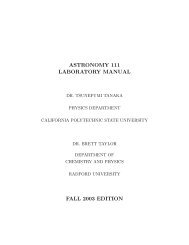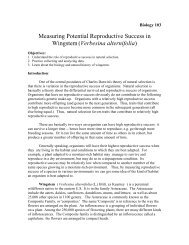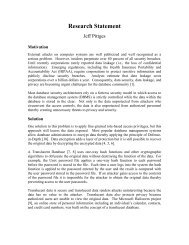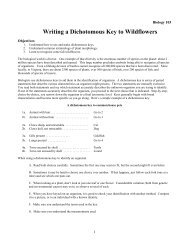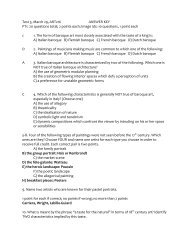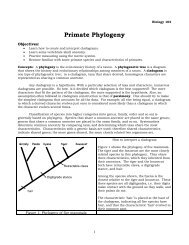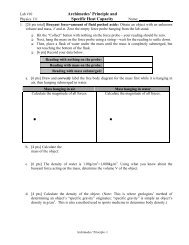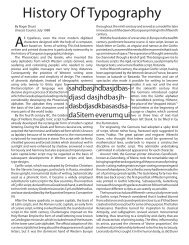Solving DDEs in Matlab - Radford University
Solving DDEs in Matlab - Radford University
Solving DDEs in Matlab - Radford University
You also want an ePaper? Increase the reach of your titles
YUMPU automatically turns print PDFs into web optimized ePapers that Google loves.
<strong>Solv<strong>in</strong>g</strong> <strong>DDEs</strong> <strong>in</strong> <strong>Matlab</strong><br />
L.F. Shamp<strong>in</strong>e<br />
Mathematics Department<br />
Southern Methodist <strong>University</strong><br />
Dallas, TX 75275<br />
lshamp<strong>in</strong>@mail.smu.edu<br />
S. Thompson<br />
Department of Mathematics & Statistics<br />
<strong>Radford</strong> <strong>University</strong><br />
<strong>Radford</strong>, VA 24142<br />
thompson@runet.edu<br />
February 9, 2000<br />
Abstract<br />
dde23 aims to make it as easy as possible to solve effectively delaydifferential<br />
equations (<strong>DDEs</strong>) with constant delays <strong>in</strong> <strong>Matlab</strong>. In this<br />
paper we discuss some of its features, <strong>in</strong>clud<strong>in</strong>g discont<strong>in</strong>uity track<strong>in</strong>g,<br />
iteration for short delays, and event location. We also develop some theoretical<br />
results that underlie the solver, <strong>in</strong>clud<strong>in</strong>g convergence, error estimation,<br />
and the effects of short delays on the evaluation of formulas and<br />
stability. Some examples illustrate the use of dde23 and show it to be a<br />
capable DDE solver that is exceptionally easy to use for a wide range of<br />
complex problems.<br />
1 Introduction<br />
Our goal is to make it as easy as possible to solve effectively a large class of delaydifferential<br />
equations (<strong>DDEs</strong>). We restrict ourselves to systems of equations of<br />
the form<br />
y ′ (x) = f(x, y(x), y(x − τ1), y(x − τ2), . . . , y(x − τk)) (1)<br />
for constant delays τj such that τ = m<strong>in</strong>(τ1, . . . , τk) > 0. The equations are to<br />
hold on a ≤ x ≤ b, which requires the history y(x) = S(x) to be given for x ≤ a.<br />
Although <strong>DDEs</strong> with delays (lags) of more general form are important, this is<br />
a large and useful class of <strong>DDEs</strong>. Indeed, Baker, Paul, and Willé [1] write that<br />
“The lag functions that arise most frequently <strong>in</strong> the modell<strong>in</strong>g literature are<br />
constants.” Restrict<strong>in</strong>g ourselves to this class of <strong>DDEs</strong> makes possible a simpler<br />
user <strong>in</strong>terface and more robust numerical solution.<br />
1
A popular approach to solv<strong>in</strong>g <strong>DDEs</strong> exploits the fact that the task has<br />
much <strong>in</strong> common with the solution of ord<strong>in</strong>ary differential equations (ODEs).<br />
Indeed, the DDE solver dde23 that we discuss here is closely related to the ODE<br />
solver ode23 from the <strong>Matlab</strong> ODE Suite [16]. In particular, our attention is<br />
focused on the Runge-Kutta triple BS(2,3) used <strong>in</strong> ode23 because it has some<br />
special properties that we exploit <strong>in</strong> dde23. In §2 we expla<strong>in</strong> how explicit<br />
Runge-Kutta triples can be extended and used to solve <strong>DDEs</strong>. This extension<br />
is greatly simplified if the maximum step size H is smaller than τ because the<br />
result<strong>in</strong>g formulas are explicit. This is no restriction when prov<strong>in</strong>g convergence<br />
as H → 0, so many papers assume it. However, we believe that it is unacceptable<br />
<strong>in</strong> a quality solver, so we also discuss how to evaluate the implicit formulas that<br />
arise when the step size is bigger than τ. In §3 we prove uniform convergence<br />
of the numerical scheme <strong>in</strong> realistic circumstances. In the follow<strong>in</strong>g section we<br />
justify an estimate of the local truncation error.<br />
Generally y ′ (a+) from (1) is different from y ′ (a−) = S ′ (a−). It is characteristic<br />
of <strong>DDEs</strong> that this discont<strong>in</strong>uity <strong>in</strong> y ′ propagates as a discont<strong>in</strong>uity <strong>in</strong> y ′′<br />
at a + τ1, . . . , a + τk. In turn these discont<strong>in</strong>uities propagate as a discont<strong>in</strong>uity<br />
<strong>in</strong> y (3) , and so forth. Locat<strong>in</strong>g and account<strong>in</strong>g for low-order discont<strong>in</strong>uities <strong>in</strong><br />
the solution is key to the use of Runge-Kutta methods for solv<strong>in</strong>g <strong>DDEs</strong>. In<br />
§5 we discuss the practical issues of locat<strong>in</strong>g these discont<strong>in</strong>uities. Any DDE<br />
solver must account for them, but dde23 also deals with discont<strong>in</strong>uous changes<br />
<strong>in</strong> f at known po<strong>in</strong>ts x <strong>in</strong> both the history and the <strong>in</strong>terval of <strong>in</strong>tegration <strong>in</strong> a<br />
similar way.<br />
Some problems <strong>in</strong>volve changes <strong>in</strong> f at po<strong>in</strong>ts that depend on the solution<br />
itself, or more generally on a function of the solution called an event function.<br />
Event functions are used to locate where y satisfies certa<strong>in</strong> conditions, e.g.,<br />
where a specific component of y(x) has a local maximum. dde23 has a powerful<br />
event location capability that is discussed <strong>in</strong> §6. It is difficult to deal with the<br />
many possibilities that are seen <strong>in</strong> practice, so provid<strong>in</strong>g this capability affected<br />
profoundly the design of the solver.<br />
The natural step size of a Runge-Kutta method is the largest that will yield<br />
the desired accuracy. Delays that are long compared to this step size and delays<br />
that are short present special difficulties for a DDE solver that we consider <strong>in</strong> §7.<br />
In the comput<strong>in</strong>g environment of <strong>Matlab</strong> brief comments about long delays<br />
suffice, but we <strong>in</strong>vestigate short delays at some length. In this we consider for<br />
the BS(2,3) triple how the iteration for evaluat<strong>in</strong>g implicit formulas behaves as<br />
the delay tends to zero <strong>in</strong> a model equation. We also consider the stability of<br />
the <strong>in</strong>tegration <strong>in</strong> the same circumstances.<br />
We close with some examples that show restrict<strong>in</strong>g the class of problems,<br />
algorithmic developments, language facilities <strong>in</strong> <strong>Matlab</strong>, and design have resulted<br />
<strong>in</strong> a DDE solver that is both capable and exceptionally easy to use. We<br />
have prepared a tutorial that shows how to use dde23. The solver and its auxiliary<br />
functions, the tutorial, and complete solutions of all the examples of the<br />
tutorial are available by anonymous ftp and at a public web site.<br />
2
2 Formulas<br />
Explicit Runge-Kutta triples are a standard way to solve the ODE problem y ′ =<br />
f(x, y) on [a, b] with given y(a). They can be extended to solve <strong>DDEs</strong>. Indeed,<br />
dde23 is closely related to the ODE solver ode23 [16] which implements the<br />
BS(2,3) triple [2]. A triple of s stages <strong>in</strong>volves three formulas. Suppose that we<br />
have an approximation yn to y(x) at xn and wish to compute an approximation<br />
at xn+1 = xn + hn. For i = 1, . . . , s, the stages fni = f(xni, yni) are def<strong>in</strong>ed <strong>in</strong><br />
terms of xni = xn + cihn and<br />
�<br />
i−1<br />
yni = yn + hn aijfnj.<br />
j=1<br />
The approximation used to advance the <strong>in</strong>tegration is<br />
s�<br />
yn+1 = yn + hn bifni.<br />
i=1<br />
For brevity we may write this <strong>in</strong> terms of the <strong>in</strong>crement function<br />
Φ(xn, yn) =<br />
s�<br />
i=1<br />
bifni.<br />
The solution satisfies this formula with a residual called the local truncation<br />
error, lten,<br />
y(xn+1) = y(xn) + hnΦ(xn, y(xn)) + lten.<br />
For sufficiently smooth f and y(x) this error is O(h p+1<br />
n ). The triple <strong>in</strong>cludes<br />
another formula,<br />
y ∗ n+1 = yn + hn<br />
s�<br />
i=1<br />
b ∗ i fni = yn + hnΦ ∗ (xn, yn).<br />
The solution satisfies this formula with a local truncation error lte∗ n that is<br />
O(hp n). This second formula is used only for select<strong>in</strong>g the step size. The third<br />
formula has the form<br />
s�<br />
bi(σ)fni = yn + hnΦ(xn, yn, σ).<br />
yn+σ = yn + hn<br />
i=1<br />
The coefficients bi(σ) are polynomials <strong>in</strong> σ, so this represents a polynomial<br />
approximation to y(xn + σhn) for 0 ≤ σ ≤ 1. We assume that this formula<br />
yields the value yn when σ = 0 and yn+1 when σ = 1. For this reason the<br />
third formula is described as a cont<strong>in</strong>uous extension of the first. A much more<br />
serious assumption is that the order of the cont<strong>in</strong>uous extension is the same as<br />
that of the first formula. These assumptions hold for the BS(2,3) triple. For<br />
such triples we regard the formula used to advance the <strong>in</strong>tegration as just the<br />
3
special case σ = 1 of the cont<strong>in</strong>uous extension. The local truncation error of<br />
the cont<strong>in</strong>uous extension is def<strong>in</strong>ed by<br />
y(xn + σhn) = y(xn) + hnΦ(xn, y(xn), σ) + lten(σ).<br />
We assume that for smooth f and y(x), there is a constant C1 such that<br />
�lten(σ)� ≤ C1hp+1 n for 0 ≤ σ ≤ 1.<br />
In his discussion of cont<strong>in</strong>uous extensions, Dormand [4] treats the local truncation<br />
error of the BS(2,3) triple as an example. In §6.3 he obta<strong>in</strong>s<br />
A (4) (σ) = σ2 � � 4 3 2 1/2<br />
1728σ − 7536σ + 13132σ − 11148σ + 3969<br />
288<br />
as a measure of the local truncation error at xn + σhn. In Figure 6.2 he shows<br />
that this measure <strong>in</strong>creases monotonely from zero at xn to a maximum at xn+1.<br />
We shall see that the solver controls the size of the error at xn+1, so the cont<strong>in</strong>uous<br />
extension of this triple provides an accurate solution throughout [xn, xn+1].<br />
To use an explicit Runge-Kutta triple to solve the DDE (1), we need a<br />
strategy for handl<strong>in</strong>g the history terms y(xni − τj) that appear <strong>in</strong><br />
fni = f(xni, yni, y(xni − τ1), . . . , y(xni − τk)).<br />
Two situations must be dist<strong>in</strong>guished: hn ≤ τ and hn > τj for some j. We<br />
beg<strong>in</strong> with the first. Suppose that we have available an approximation S(x) to<br />
y(x) for all x ≤ xn. If hn ≤ τ, then all the xni − τj ≤ xn and<br />
fni = f(xni, yni, S(xni − τ1), . . . , S(xni − τk))<br />
is an explicit recipe for the stage and the formulas are explicit. The function<br />
S(x) is the <strong>in</strong>itial history for x ≤ a. After tak<strong>in</strong>g the step to xn+1, we use the<br />
cont<strong>in</strong>uous extension to def<strong>in</strong>e S(x) on [xn, xn+1] as S(xn + σhn) = yn+σ. We<br />
are then ready to take another step. This suffices for prov<strong>in</strong>g convergence as<br />
the maximum step size tends to zero, but we must take up the other situation<br />
because <strong>in</strong> practice, we may very well want to use a step size larger than the<br />
smallest delay. When hn > τj for some j, the “history” term S(x) is evaluated<br />
<strong>in</strong> the span of the current step and the formulas are def<strong>in</strong>ed implicitly. In this<br />
situation we evaluate the formulas with simple iteration. On reach<strong>in</strong>g xn, we<br />
have def<strong>in</strong>ed S(x) for x ≤ xn. We extend its def<strong>in</strong>ition somehow to (xn, xn +hn]<br />
and call the result<strong>in</strong>g function S (0) (x). A typical stage of simple iteration beg<strong>in</strong>s<br />
with the approximate solution S (m) (x). The next iterate is computed with the<br />
explicit formula<br />
S (m+1) (xn + σhn) = yn + hnΦ(xn, yn, σ; S (m) (x)).<br />
In the next section we show that if the step size is small enough, this is a<br />
contraction and S(x) is well-def<strong>in</strong>ed for x ≤ xn+1.<br />
In dde23 we predict S (0) (x) to be the constant y0 for the first step. We do<br />
not attempt to predict more accurately then because the solution is not smooth<br />
4<br />
(2)
at a and we do not yet know a step size appropriate to the scale of the problem.<br />
Indeed, reduc<strong>in</strong>g the step size as needed to obta<strong>in</strong> convergence of simple iteration<br />
is a valuable tactic for f<strong>in</strong>d<strong>in</strong>g an <strong>in</strong>itial step size that is on scale, c.f. [14]. After<br />
the first step, we use the cont<strong>in</strong>uous extension of the preced<strong>in</strong>g step as S (0) (x)<br />
for the current step. This prediction has an appropriate order of accuracy<br />
and we can even assess the accuracy quantitatively us<strong>in</strong>g (2). Remarkably, the<br />
truncation error has a local maximum at xn+1 so that extrapolation actually<br />
provides a more accurate solution for some distance. Specifically, the ratio of<br />
the error of yn+σ to the error of yn+1 is no larger than 1 for σ up to about<br />
1.32. Much more important <strong>in</strong> practice is the accuracy of the prediction <strong>in</strong> the<br />
span of a subsequent step of the same size or rather larger. Unfortunately, the<br />
ratio grows rapidly as σ <strong>in</strong>creases. Still, it is no bigger than 13 for 1 ≤ σ ≤ 2,<br />
so the prediction is quite good when the step size is chang<strong>in</strong>g slowly. The<br />
step size adjustment algorithms of dde23 are those of ode23 augmented to<br />
deal with implicit formulas. The convergence test for simple iteration is that<br />
�y (m+1)<br />
n+1 − y(m) n+1� is no more than one tenth the accuracy required of yn+1.<br />
Because each iteration costs as much as an explicit step, any proposed hn with<br />
τ < hn < 2τ is reduced to τ so as to make the formulas explicit. Consider<strong>in</strong>g<br />
the quality of the prediction when hn ≥ 2τ, we have allowed up to 5 iterations.<br />
If convergence is not achieved, hn is halved and the step repeated. The solver<br />
cannot crash because of repeated convergence failures because eventually it will<br />
resort to a step size for which the formulas are explicit.<br />
3 Convergence<br />
Theorem Suppose an explicit Runge-Kutta triple is used to solve the DDE (1)<br />
as described <strong>in</strong> the preced<strong>in</strong>g section. Assume that the meshes {xn} <strong>in</strong>clude all<br />
discont<strong>in</strong>uities of low orders and that the maximum step size H satisfies (5)<br />
and (7). If f satisfies a Lipschitz condition <strong>in</strong> its dependent variables and is<br />
sufficiently smooth <strong>in</strong> all its variables, then there exists a constant C such that<br />
for a ≤ x ≤ b,<br />
�y(x) − S(x)� ≤ CH p . (3)<br />
Before prov<strong>in</strong>g this result, we beg<strong>in</strong> our <strong>in</strong>vestigation of convergence by<br />
recall<strong>in</strong>g the comments earlier about how discont<strong>in</strong>uities arise and propagate<br />
for <strong>DDEs</strong>. We know <strong>in</strong> advance all the po<strong>in</strong>ts where the solution might not be<br />
smooth enough for the usual orders of the formulas to hold. Because we consider<br />
one-step methods, if we take these po<strong>in</strong>ts to be mesh po<strong>in</strong>ts, the analysis is the<br />
same as if the solution were smooth throughout the <strong>in</strong>terval. Accord<strong>in</strong>gly, we<br />
consider a sequence of meshes {xn} which <strong>in</strong>clude all these po<strong>in</strong>ts. Just how<br />
this is accomplished <strong>in</strong> practice is described <strong>in</strong> §5. Between these po<strong>in</strong>ts we<br />
assume that f and y(x) are smooth enough for the formulas to have their usual<br />
orders. We also assume that f satisfies a Lipschitz condition with respect to<br />
all the dependent variables. For the sake of simplicity, we suppose that there is<br />
5
only one delay and take the Lipschitz condition <strong>in</strong> the form<br />
�f(x, ˜y, ˜z) − f(x, y, z)� ≤ L max(�˜y − y�, �˜z − z�).<br />
The Runge-Kutta formulas extended to <strong>DDEs</strong> <strong>in</strong>volve a history term that<br />
we write generically <strong>in</strong> the <strong>in</strong>crement function as g(x). We require two lemmas<br />
about how the <strong>in</strong>crement functions depend on their arguments.<br />
Lemma 1 There is a constant L such that for 0 ≤ σ ≤ 1,<br />
�Φ(xn, ˜yn, σ; g(x)) − Φ(xn, yn, σ; g(x))� ≤ L�˜yn − yn�. (4)<br />
Proof: In a step of size hn from (xn, ˜yn), the <strong>in</strong>termediate quantities ˜yni are<br />
def<strong>in</strong>ed by<br />
˜yni = ˜yn + hn<br />
j=1<br />
�i−1<br />
aijf(xnj, ˜ynj, g(xnj − τ))<br />
and the yni are def<strong>in</strong>ed similarly <strong>in</strong> a step from (xn, yn). Us<strong>in</strong>g the Lipschitz<br />
condition on f, it is straightforward to show that for each i, there is a constant<br />
Li such that<br />
⎛<br />
⎞<br />
�i−1<br />
�˜yni − yni� ≤ ⎝1 + HL Lj|aij| ⎠ �˜yn − yn� = Li�˜yn − yn�.<br />
j=1<br />
With this result it follows easily that (4) holds with L = L �s i=1 Li max(|bi(σ)|).<br />
The second lemma we need is a bound on the effect of us<strong>in</strong>g different history<br />
terms.<br />
Lemma 2 Let ∆ be a bound on �G(x)−g(x)� for all x ≤ xn+1. If the maximum<br />
step size H is small enough that<br />
⎛ ⎞<br />
HL max<br />
i<br />
then there is a constant Γ such that<br />
�i−1<br />
⎝<br />
j=1<br />
|aij|<br />
⎠ ≤ 1 (5)<br />
�Φ(xn, yn, σ; G(x)) − Φ(xn, yn, σ; g(x))� ≤ Γ∆. (6)<br />
Proof: Let the <strong>in</strong>termediate quantities of the two formulas be<br />
and<br />
rni = yn + hn<br />
sni = yn + hn<br />
�i−1<br />
aijf(xnj, rnj, G(xnj − τ))<br />
j=1<br />
�i−1<br />
aijf(xnj, snj, g(xnj − τ)).<br />
j=1<br />
6
The Lipschitz condition on f, <strong>in</strong>equality (5), and a simple <strong>in</strong>duction argument<br />
show that for each i,<br />
�i−1<br />
�rni − sni� ≤ hn |aij|L∆ ≤ ∆.<br />
With this result it follows easily that (6) holds with Γ = L � s<br />
i=1 max(|bi(σ)|).<br />
Recall that if the step size is small enough, the <strong>in</strong>termediate results yni are<br />
def<strong>in</strong>ed by the explicit formulas<br />
yni = yn + hn<br />
j=1<br />
�i−1<br />
aijf(xnj, ynj, S(xnj − τ)),<br />
j=1<br />
but if hn > τ, we may have some xnj − τj > xn so that S(x) is evaluated<br />
<strong>in</strong> the span of the current step. In this situation we evaluate the formulas<br />
with simple iteration as described <strong>in</strong> the preced<strong>in</strong>g section. Us<strong>in</strong>g this lemma<br />
we obta<strong>in</strong> a condition on the maximum step size that <strong>in</strong>sures the convergence<br />
of simple iteration: Let ∆ (m) be the maximum of �S (m+1) (x) − S (m) (x)� for<br />
xn ≤ x ≤ xn+1. (The functions are the same for x ≤ xn.) Inequality (6)<br />
implies that ∆ (m) ≤ hnΓ∆ (m−1) ≤ HΓ∆ m−1 . From this it is obvious that<br />
simple iteration is contract<strong>in</strong>g and the formula is well-def<strong>in</strong>ed if the maximum<br />
step size H is small enough to satisfy both (5) and<br />
HΓ = HL<br />
s�<br />
i=1<br />
max(|bi(σ)|) ≤ 1<br />
. (7)<br />
2<br />
We are now <strong>in</strong> a position to prove convergence as H → 0 when the meshes<br />
<strong>in</strong>clude all discont<strong>in</strong>uities of low order and H satisfies (5) and (7). Suppose that<br />
the <strong>in</strong>tegration has reached xn and let En be a bound on �y(x) − S(x)� for all<br />
x ≤ xn. The local truncation error of the cont<strong>in</strong>uous extension is def<strong>in</strong>ed by<br />
If we <strong>in</strong>troduce<br />
y(xn + σhn) = y(xn) + hnΦ(xn, y(xn), σ; y(x)) + lten(σ).<br />
wn+σ = yn + hnΦ(xn, yn, σ; y(x))<br />
then <strong>in</strong>equality (4) and our assumption about the local truncation error imply<br />
that for 0 ≤ σ ≤ 1,<br />
�y(xn + σhn) − wn+σ� ≤ (1 + hnL)�y(xn) − yn� + �lten(σ)�<br />
≤ (1 + hnL)En + C1h p+1<br />
n .<br />
The numerical solution is<br />
yn+σ = yn + hnΦ(xn, yn, σ; S(x)).<br />
7
The next step of the proof is complicated by the possibility that this formula<br />
is implicit. If we let ∆ be the maximum of �y(x) − S(x)� for x ≤ xn+1, then<br />
<strong>in</strong>equality (6) states that<br />
�yn+σ − wn+σ� = hn�Φ(xn, yn, σ; S(x)) − Φ(xn, yn, σ; y(x))� ≤ hnΓ∆<br />
and the triangle <strong>in</strong>equality implies that<br />
�y(xn + σhn) − yn+σ� ≤ (1 + hnL)En + C1h p+1<br />
n<br />
+ hnΓ∆.<br />
This is a bound on �y(x) − S(x)� for xn ≤ x ≤ xn+1 and by def<strong>in</strong>ition of En,<br />
the bound also holds for all x ≤ xn. We conclude that<br />
∆ ≤ (1 + hnL)En + C1h p+1<br />
n<br />
+ hnΓ∆.<br />
With the assumption that H satisfies (7), it then follows that<br />
∆ ≤<br />
1 + hnL<br />
1 − hnΓ En + C1<br />
1 − hnΓ hp+1 n ≤ (1 + 2(L + Γ)hn) En + 2C1h p+1<br />
n .<br />
If we let C2 = 2(L + Γ) and C3 = 2C1, this <strong>in</strong>equality tells us that<br />
En+1 = (1 + hnC2)En + C3h p+1<br />
n<br />
is a bound on �y(x) − S(x)� for all x ≤ xn+1. Because we start with the given<br />
<strong>in</strong>itial history, E0 = 0. A simple <strong>in</strong>duction argument shows that for all n,<br />
The uniform bound<br />
implies (3) for a ≤ x ≤ b.<br />
En ≤ C3e C2(xn−a) (xn − a)H p .<br />
En ≤ C3e C2(b−a) (b − a)H p = CH p<br />
4 Error Estimation and Control<br />
Nowadays codes based on explicit Runge-Kutta triples estimate and control the<br />
error made <strong>in</strong> the current step by the lower order formula. They advance the<br />
<strong>in</strong>tegration with the higher order result yn+1 (local extrapolation) because it is<br />
more accurate, though just how much is not known. Our notation and proof<br />
of convergence <strong>in</strong>corporate this assumption about the triple. We make use of<br />
local extrapolation <strong>in</strong> our proof that we can estimate the local truncation error<br />
of the lower order formula, lte ∗ n, by the computable quantity est = yn+1 − y ∗ n+1.<br />
The local truncation error<br />
lte ∗ n = (y(xn+1) − y(xn)) − hnΦ ∗ (xn, y(xn); y(x))<br />
8
is O(h p n). Us<strong>in</strong>g the correspond<strong>in</strong>g def<strong>in</strong>ition of lten it follows easily that<br />
lte ∗ n = hnΦ(xn, y(xn); y(x)) − hnΦ ∗ (xn, y(xn); y(x)) + O(h p+1<br />
n ).<br />
From the def<strong>in</strong>ition of yn+1 we have<br />
hnΦ(xn, yn; S(x)) = yn+1 − yn.<br />
Us<strong>in</strong>g the convergence result (3), we show now that<br />
hnΦ(xn, y(xn); y(x)) = hnΦ(xn, yn; S(x)) + O(hnH p ).<br />
First we use <strong>in</strong>equality (4) to see that<br />
�hnΦ(xn, y(xn); y(x)) − hnΦ(xn, yn; y(x))� ≤ hnL�y(xn) − yn� ≤ hnLCH p<br />
and then <strong>in</strong>equality (6) to see that<br />
�hnΦ(xn, yn; y(x)) − hnΦ(xn, yn; S(x))� ≤ hnΓCH p .<br />
The desired relation follows from the triangle <strong>in</strong>equality. The same argument<br />
establishes the correspond<strong>in</strong>g relation for the lower order formula. With these<br />
two relations we have<br />
lte ∗ n = hnΦ(xn, yn; S(x)) − hnΦ ∗ (xn, yn; S(x)) + O(hnH p )<br />
= (yn+1 − yn) − (y ∗ n+1 − yn) + O(hnH p )<br />
= est + O(hnH p )<br />
which justifies our estimate of the local truncation error.<br />
As with ODEs, the local truncation error can be expanded to<br />
lte ∗ n = φ ∗ (xn, y(xn); y(x))h p n + O(h p+1<br />
n ).<br />
If we reject the step of size hn from (xn, yn), we predict the local truncation<br />
error of another attempt of size h to be<br />
est (h/hn) p ≈ φ ∗ (xn, y(xn); y(x))h p .<br />
The same prediction applies to a step of size h from (xn+1, yn+1) on mak<strong>in</strong>g<br />
the approximation φ ∗ (xn+1, y(xn+1); y(x)) ≈ φ ∗ (xn, y(xn); y(x)) because the<br />
change <strong>in</strong> each of the arguments is O(hn).<br />
We control the local truncation error of y ∗ n+1, but advance the <strong>in</strong>tegration<br />
with yn+1 because it is believed to be more accurate. Recall that for the BS(2,3)<br />
triple, the local truncation error of yn+σ atta<strong>in</strong>s its maximum for yn+1. Accord<strong>in</strong>gly,<br />
though we do not know the local truncation error of the cont<strong>in</strong>uous<br />
extension, we believe that it is smaller than required throughout the span of the<br />
step.<br />
9
5 Track<strong>in</strong>g Discont<strong>in</strong>uities<br />
The constant lags τ1, . . . , τk are supplied to dde23 as the array lags. It is<br />
required that τ = m<strong>in</strong>(τ1, . . . , τk) > 0 and that the delays are dist<strong>in</strong>ct. In<br />
simplest use the only discont<strong>in</strong>uity is at the <strong>in</strong>itial po<strong>in</strong>t where the derivative<br />
obta<strong>in</strong>ed from the DDE, y ′ (a+) = f(a, y(a), y(a − τ1), y(a − τ2), . . . , y(a − τk)),<br />
is generally different from that provided by the history, S ′ (a−). Generally the<br />
solution itself is cont<strong>in</strong>uous at the <strong>in</strong>itial po<strong>in</strong>t, so we defer consideration of<br />
the case when it is not. It is characteristic of <strong>DDEs</strong> that this discont<strong>in</strong>uity<br />
<strong>in</strong> the first derivative results <strong>in</strong> discont<strong>in</strong>uities <strong>in</strong> the second derivative at a +<br />
τ1, . . . , a + τk. We describe this as discont<strong>in</strong>uities at the first level. In turn<br />
each of these discont<strong>in</strong>uities propagates <strong>in</strong> the next level as a discont<strong>in</strong>uity <strong>in</strong><br />
the third derivative, and so forth. This is much simpler than the situation with<br />
more general <strong>DDEs</strong> because we can determ<strong>in</strong>e easily, and <strong>in</strong> advance, where the<br />
solution might have discont<strong>in</strong>uities and the lowest order discont<strong>in</strong>uity possible<br />
there. Some solvers ask users to supply details about which y(x − τj) appear <strong>in</strong><br />
which equations so as to determ<strong>in</strong>e more precisely how discont<strong>in</strong>uities propagate.<br />
We th<strong>in</strong>k that the <strong>in</strong>convenience of this design outweighs any advantages ga<strong>in</strong>ed<br />
<strong>in</strong> the solution of the <strong>DDEs</strong>. Moreover, assum<strong>in</strong>g that the worst can happen<br />
is more robust because there is no opportunity for a user to make a mistake <strong>in</strong><br />
specify<strong>in</strong>g the structure of the <strong>DDEs</strong>.<br />
We have to track discont<strong>in</strong>uities and account for them dur<strong>in</strong>g the <strong>in</strong>tegration<br />
because the usual order of a Runge-Kutta formula is seen <strong>in</strong> a step of size hn from<br />
xn only when f(x, y(x), y(x−τ1), y(x−τ2), . . . , y(x−τk)) is sufficiently smooth.<br />
As we have described the solution of <strong>DDEs</strong> with explicit Runge-Kutta methods,<br />
each step is taken with two formulas <strong>in</strong> order to estimate the error made <strong>in</strong> the<br />
step. If the error estimation and step size adjustment algorithms are to work<br />
properly, f must be smooth enough for both to have their expected order. If<br />
we require that the step size be chosen so that each po<strong>in</strong>t of discont<strong>in</strong>uity is a<br />
mesh po<strong>in</strong>t xm, then none of y(x), y(x − τ1), . . . , y(x − τk) will have a low order<br />
discont<strong>in</strong>uity <strong>in</strong> the span of the current step. This is obvious for a discont<strong>in</strong>uity<br />
<strong>in</strong> the argument y(x). There cannot be a ξ <strong>in</strong> (xn, xn + hn) for which some<br />
y(ξ − τj) is not smooth because the discont<strong>in</strong>uity <strong>in</strong> y at ξ − τj would have<br />
propagated to ξ and we would have limited hn so that xn + hn ≤ ξ. Because we<br />
consider only one-step methods, it is only the smoothness of f <strong>in</strong> the current step<br />
that affects the order of the formula. This is true even if y or f is discont<strong>in</strong>uous<br />
at xn provided that the correct values are used at xn+, but we need take no<br />
special action <strong>in</strong> the solver because with one exception that we take up later,<br />
we assume these functions are (at least) cont<strong>in</strong>uous.<br />
Although constant delays simplify greatly the location of potential discont<strong>in</strong>uities,<br />
there are some subtleties. One is revealed by a simple example. Suppose<br />
we start the <strong>in</strong>tegration at x = 0 and the delays are 1/3 and 1. The first lag<br />
implies a potentially severe lack of smoothness at 1/3, 2/3, 1, . . .. The difficulty<br />
is that <strong>in</strong> f<strong>in</strong>ite precision arithmetic, representation of 1/3 is not exact, imply<strong>in</strong>g<br />
that the propagated value that ought to be 1 is merely very close to the correct<br />
value. Generally this is not important, but the lag of 1 implies a discont<strong>in</strong>uity<br />
10
precisely at 1. We must recognize that f<strong>in</strong>ite precision arithmetic has split two<br />
values that are the same else the requirement that the solver step to po<strong>in</strong>ts of<br />
discont<strong>in</strong>uity will cause it to attempt steps that are too short to be mean<strong>in</strong>gful<br />
<strong>in</strong> the precision available. In dde23 we purge one of any pair of values that differ<br />
by no more than ten units of roundoff. This is done at each level of propagation<br />
so as to remove duplicates as soon as possible.<br />
Example 4.4 of Oberle and Pesch [11] is a model for the spread of an <strong>in</strong>fection<br />
due to Hoppensteadt and Waltman. The problem is posed on [0, 10] and there<br />
is one lag, τ = 1. The solution is cont<strong>in</strong>uous throughout the <strong>in</strong>terval, but<br />
there are discont<strong>in</strong>uous changes <strong>in</strong> the differential equation at po<strong>in</strong>ts known <strong>in</strong><br />
advance. Indeed, the changes are qualitative because at first the equation does<br />
not depend on y(x−1), hence is an ODE. We provide <strong>in</strong> dde23 for discont<strong>in</strong>uities<br />
at po<strong>in</strong>ts known <strong>in</strong> advance. All the user need do is give the locations of potential<br />
discont<strong>in</strong>uities as the value of the option ’Jumps’. As with the ODE Suite,<br />
options for dde23 are set with an auxiliary function, ddeset. In the case of the<br />
Hoppensteadt-Waltman model, the three po<strong>in</strong>ts where discont<strong>in</strong>uities occur are<br />
def<strong>in</strong>ed by<br />
c = 1/sqrt(2);<br />
options = ddeset(’Jumps’,[(1-c), 1, (2-c)]);<br />
and conveyed to the solver by means of the optional argument options. Discont<strong>in</strong>uities<br />
at known po<strong>in</strong>ts are not limited to the <strong>in</strong>terval of <strong>in</strong>tegration. The<br />
Marchuk immunology model discussed <strong>in</strong> [6, pp. 297–298] is solved on [0, 60]<br />
and there is one lag, τ = 0.5. One component of the history function is<br />
V (t) = max(0, t + 10 −6 ). Clearly V (t) has a discont<strong>in</strong>uity <strong>in</strong> its first derivative<br />
at t = −10 −6 . Hairer, Nørsett, and Wanner do not account for this discont<strong>in</strong>uity,<br />
even though it is as severe as the one at the <strong>in</strong>itial po<strong>in</strong>t. With the user<br />
<strong>in</strong>terface of dde23 it is easy to specify discont<strong>in</strong>uities at known po<strong>in</strong>ts and they<br />
are accommodated <strong>in</strong> the algorithm simply by form<strong>in</strong>g an array that <strong>in</strong>cludes<br />
these po<strong>in</strong>ts as well as the <strong>in</strong>itial po<strong>in</strong>t and then propagat<strong>in</strong>g them all as described<br />
already for the <strong>in</strong>itial po<strong>in</strong>t. Some details of the solution of the Marchuk<br />
model are provided <strong>in</strong> §8. When us<strong>in</strong>g a solver with the capabilities of dde23<br />
it is easy and certa<strong>in</strong>ly better practice to specify discont<strong>in</strong>uities like those of<br />
these two examples, but a robust <strong>in</strong>tegrator may well be able to cope with them<br />
automatically.<br />
Much more serious complications are <strong>in</strong>troduced by cont<strong>in</strong>uation (restarts).<br />
As we discuss more fully <strong>in</strong> §6, we provide for the location of events. This<br />
capability is used, for example, to deal with a coefficient ξ(m) <strong>in</strong> the Marchuk<br />
model that has a jump <strong>in</strong> its first derivative with respect to the state variable<br />
m(t). Restart<strong>in</strong>g the <strong>in</strong>tegration when this happens assures us that the formulas<br />
are applied only to smooth functions. Reta<strong>in</strong><strong>in</strong>g the solution <strong>in</strong> the form of a<br />
structure makes it possible to cont<strong>in</strong>ue. For the present we note only that we<br />
must <strong>in</strong>clude <strong>in</strong> the solution structure the list of potential discont<strong>in</strong>uities. After<br />
all, we might have discarded po<strong>in</strong>ts outside the orig<strong>in</strong>al <strong>in</strong>terval of <strong>in</strong>tegration<br />
that lie <strong>in</strong> the span of the current <strong>in</strong>terval. Accord<strong>in</strong>gly, on a restart this list,<br />
any jumps specified by the user <strong>in</strong> the current <strong>in</strong>tegration, and the <strong>in</strong>itial po<strong>in</strong>t<br />
11
of the current <strong>in</strong>tegration are formed <strong>in</strong>to an array. The entries are propagated<br />
and duplicates purged as described earlier.<br />
An <strong>in</strong>itial discont<strong>in</strong>uity <strong>in</strong> the first derivative appears <strong>in</strong> derivatives of successively<br />
higher order. When the discont<strong>in</strong>uities are <strong>in</strong> a derivative of sufficiently<br />
high order that they do not affect the order of the formulas, we can stop track<strong>in</strong>g<br />
them. The relatively low order of the BS(2,3) triple implies that the effects<br />
of discont<strong>in</strong>uities are rather more short-lived than with other popular formulas.<br />
Our basic assumption is that y(x) is cont<strong>in</strong>uous, so only four levels of propagation<br />
are needed. Dur<strong>in</strong>g the <strong>in</strong>tegration itself, the only time we permit a<br />
discont<strong>in</strong>uity <strong>in</strong> y(x) is at the <strong>in</strong>itial po<strong>in</strong>t, which is <strong>in</strong>dicated by provid<strong>in</strong>g the<br />
value of the solution as the value of the option ’InitialY’. The DDE is evaluated<br />
us<strong>in</strong>g this value, so both y and f are cont<strong>in</strong>uous to the right of the <strong>in</strong>itial<br />
po<strong>in</strong>t. The facilities of dde23 allow us to deal with discont<strong>in</strong>uous changes <strong>in</strong> the<br />
solution at other times. If the discont<strong>in</strong>uity occurs dur<strong>in</strong>g the <strong>in</strong>tegration, as for<br />
example at the time of occurrence of an event, the <strong>in</strong>tegration is to be restarted<br />
with the appropriate value of the solution supplied via ’InitialY’. Potential<br />
discont<strong>in</strong>uities of any order <strong>in</strong> the <strong>in</strong>itial history are specified via the ’Jumps’<br />
option. If either k<strong>in</strong>d of discont<strong>in</strong>uity <strong>in</strong> y(x) is possible, discont<strong>in</strong>uities are<br />
propagated to one higher level <strong>in</strong> the solver.<br />
The Hoppensteadt–Waltman model <strong>in</strong>volves the solution of ODEs as well as<br />
<strong>DDEs</strong>. The solver makes no assumption about whether terms with lags actually<br />
appear <strong>in</strong> the equations. This makes it possible to solve ODEs, though it is best<br />
then to set lags = [] because any delay specified affects the list of potential<br />
low-order discont<strong>in</strong>uities, hence the details of the <strong>in</strong>tegration.<br />
6 Event Location<br />
Recall that the Marchuk model has a coefficient ξ(m) that has a jump <strong>in</strong> its<br />
first derivative with respect to the state variable m(t). Such discont<strong>in</strong>uities are<br />
qualitatively different from the discont<strong>in</strong>uities that we treat with the ’Jumps’<br />
option because they occur at unknown times. An event is said to occur at time t ∗<br />
when a scalar function g(t, y(t), y(t−τ1), . . . , y(x−τk)), called an event function,<br />
vanishes at t = t ∗ . There may be many event functions and it may be important<br />
how the function vanishes, but we defer discussion of these complications. As<br />
with the propagated discont<strong>in</strong>uities, if we locate events and restart there, we<br />
<strong>in</strong>tegrate only with smooth functions. The theoretical and practical difficulties<br />
of event location are often not appreciated, but a theoretical analysis is possible<br />
with reasonable assumptions, e.g. [17], and a number of quality ODE solvers<br />
provide for the location of events. In particular, all the solvers of the <strong>Matlab</strong><br />
ODE Suite have a powerful event location capability that we have exploited<br />
<strong>in</strong> develop<strong>in</strong>g dde23. The capability is realized by means of the zero–f<strong>in</strong>d<strong>in</strong>g<br />
function odezero. A nice exposition of its algorithm is found <strong>in</strong> C.B. Moler [9].<br />
Although we did not change the basic algorithm, we modified the function to<br />
account for the circumstances of dde23.<br />
The user <strong>in</strong>terface for event location <strong>in</strong> dde23 is similar to that of ode23.<br />
12
There is no limit on the number of scalar event functions. They are all evaluated<br />
<strong>in</strong> a s<strong>in</strong>gle function and the values returned as a vector. Us<strong>in</strong>g ddeset, the name<br />
of this function is passed to the solver as the value of the ’Events’ option. The<br />
function must also return some <strong>in</strong>formation about the nature of the events.<br />
Sometimes a user wants to know when events occur and the solution then,<br />
e.g., where a solution component has its local maxima and its values there.<br />
This is quite different from the events of the Marchuk model which cause the<br />
<strong>in</strong>tegration to be term<strong>in</strong>ated. The two situations are dist<strong>in</strong>guished us<strong>in</strong>g a vector<br />
isterm<strong>in</strong>al. If we want to term<strong>in</strong>ate the <strong>in</strong>tegration when event function k<br />
vanishes, we set component k of isterm<strong>in</strong>al to 1, and otherwise to 0. There<br />
is an annoy<strong>in</strong>g matter of some importance: Sometimes we want to start an<br />
<strong>in</strong>tegration with an event function that vanishes at the <strong>in</strong>itial po<strong>in</strong>t. Imag<strong>in</strong>e,<br />
for example, that we fire a model rocket <strong>in</strong>to the air and we want to know when<br />
it hits the ground. It is natural to use the height of the rocket as a term<strong>in</strong>al event<br />
function, but it vanishes at the <strong>in</strong>itial time as well as the f<strong>in</strong>al time. dde23 treats<br />
an event at the <strong>in</strong>itial po<strong>in</strong>t <strong>in</strong> a special way. The solver locates such an event<br />
and reports it, but does not treat it as term<strong>in</strong>al, no matter how isterm<strong>in</strong>al is<br />
set. It may be important how an event function vanishes. For example, to f<strong>in</strong>d<br />
local maxima of a solution component, we can locate zeros of the first derivative<br />
of this component. However, to dist<strong>in</strong>guish maxima from m<strong>in</strong>ima, we want the<br />
solver to report a zero only when this function decreases through 0. This is done<br />
us<strong>in</strong>g the vector direction. If we are <strong>in</strong>terested only <strong>in</strong> events for which event<br />
function k is <strong>in</strong>creas<strong>in</strong>g through 0, we set component k of direction to +1.<br />
Correspond<strong>in</strong>gly, we set it to −1 if we are <strong>in</strong>terested only <strong>in</strong> those events for<br />
which the event function is decreas<strong>in</strong>g, and 0 if we are <strong>in</strong>terested <strong>in</strong> all events.<br />
As a concrete example, the event function for the Marchuk model can be coded<br />
as<br />
function [value,isterm<strong>in</strong>al,direction] = marchuke(t,y,Z,h6,state)<br />
value = y(4) - 0.1;<br />
isterm<strong>in</strong>al = 1;<br />
direction = 0;<br />
We defer discussion of the <strong>in</strong>put arguments until §8. The solution component<br />
y(4) ≈ m(t), so the (s<strong>in</strong>gle) event function is m(t) − 0.1. The value of<br />
isterm<strong>in</strong>al <strong>in</strong>dicates that the <strong>in</strong>tegration is to term<strong>in</strong>ate when an event is<br />
located and the value of direction, that all zeros are to be reported.<br />
It is hard to devise a good <strong>in</strong>terface for event location because users may<br />
want to do quite different th<strong>in</strong>gs when an event occurs. We have dist<strong>in</strong>guished<br />
between term<strong>in</strong>al and non-term<strong>in</strong>al events. dde23 returns its solution <strong>in</strong> the<br />
form of a structure. It can be called anyth<strong>in</strong>g, but to be specific, suppose it<br />
is called sol. Often a user will want to know when an event occurred, what<br />
the solution is there, and which event function vanished. This <strong>in</strong>formation is<br />
returned by means of fields that have fixed names. If there are events, they<br />
occur at the entries of the vector sol.xe. For each entry, the solution there is<br />
the correspond<strong>in</strong>g column of the array sol.ye. Also, the correspond<strong>in</strong>g entry<br />
of the vector sol.ie is the <strong>in</strong>dex of the event function that vanished.<br />
13
Often an event is term<strong>in</strong>al because it is necessary to change the function<br />
def<strong>in</strong><strong>in</strong>g the equations, as with the Marchuk model, and/or the value of the<br />
solution before cont<strong>in</strong>u<strong>in</strong>g the <strong>in</strong>tegration. The user <strong>in</strong>terface for event location<br />
<strong>in</strong> ode23 is powerful and reasonably convenient when solv<strong>in</strong>g ODEs because<br />
on a return from a term<strong>in</strong>al event, it is not difficult to make such changes,<br />
cont<strong>in</strong>ue on as the solution of a new problem, and f<strong>in</strong>ally assemble the solutions<br />
on sub<strong>in</strong>tervals to obta<strong>in</strong> a solution on the whole <strong>in</strong>terval of <strong>in</strong>terest. The<br />
matter is much more difficult for <strong>DDEs</strong> because they <strong>in</strong>volve previously given<br />
or computed quantities. On a restart, the solver may have to evaluate the given<br />
history function, which can be specified either as a function or a vector, as well<br />
as evaluate the solution computed prior to the restart. As mentioned <strong>in</strong> §5,<br />
propagated discont<strong>in</strong>uities also present complications. We deal with restarts<br />
by allow<strong>in</strong>g the history to be specified as a solution structure. This structure<br />
conta<strong>in</strong>s all the <strong>in</strong>formation the solver needs to recognize and deal with the<br />
various possibilities. The approach is easy for the user, <strong>in</strong>deed, easier than<br />
when solv<strong>in</strong>g ODEs because the solution structure always conta<strong>in</strong>s the solution<br />
from the <strong>in</strong>itial po<strong>in</strong>t to the last po<strong>in</strong>t reached <strong>in</strong> the <strong>in</strong>tegration.<br />
As stated earlier, discont<strong>in</strong>uities <strong>in</strong> the solution are allowed only at the <strong>in</strong>itial<br />
po<strong>in</strong>t of an <strong>in</strong>tegration. The solver is told of this and given the value of the solution<br />
there by provid<strong>in</strong>g it as the value of the option ’InitialY’. Discont<strong>in</strong>uities<br />
<strong>in</strong> the solution are not common, and when they do occur, they <strong>in</strong>variably do so<br />
when a suitably def<strong>in</strong>ed event function vanishes. By mak<strong>in</strong>g the event term<strong>in</strong>al,<br />
we can use the ’InitialY’ option to give the solution the correct <strong>in</strong>itial value<br />
for cont<strong>in</strong>uation.<br />
7 Long and Short Delays<br />
The “natural” step size is the largest one that yields the specified accuracy.<br />
Codes for the solution of <strong>DDEs</strong> have difficulties when the delays are both long<br />
and short compared to the natural step size. Long delays present no special<br />
difficulty for dde23, so after a brief discussion we turn to the troublesome matter<br />
of short delays.<br />
Many solvers are written <strong>in</strong> FORTRAN 77 which lacks the facilities for dynamic<br />
memory management seen <strong>in</strong> Fortran 90 and more conveniently <strong>in</strong> <strong>Matlab</strong>.<br />
On reach<strong>in</strong>g a po<strong>in</strong>t xn <strong>in</strong> the <strong>in</strong>tegration the solver will need to evaluate<br />
the solution at previous po<strong>in</strong>ts xn − τj, hence must reta<strong>in</strong> the <strong>in</strong>formation it<br />
needs to do this. When there is a delay long compared to the natural step size<br />
this implies that the solution must be reta<strong>in</strong>ed over many steps. The difficulty<br />
is that <strong>in</strong> an environment like FORTRAN 77 which requires allocation of storage<br />
at the beg<strong>in</strong>n<strong>in</strong>g of a run, there is a possibility of exceed<strong>in</strong>g the storage<br />
provided. This is not an issue for us because we have followed the traditional<br />
design of ODE solvers <strong>in</strong> <strong>Matlab</strong> of return<strong>in</strong>g to the user the solution at all<br />
mesh po<strong>in</strong>ts. Virtual storage and dynamic memory management <strong>in</strong>crease the<br />
class of problems that can be solved, but we assume that long delays will not<br />
prevent solution of the problem given. We remark that <strong>Matlab</strong> will handle<br />
14
automatically allocation of additional storage, but we follow the ODE Suite<br />
<strong>in</strong> allocat<strong>in</strong>g explicitly additional storage as needed because it reduces the run<br />
time.<br />
A short delay is a more troublesome matter that is related to stiffness. A<br />
problem is stiff when the natural step size must be reduced greatly and often.<br />
Although the reduction necessary for the stability of explicit formulas gets the<br />
most attention, [14] po<strong>in</strong>ts out reductions aris<strong>in</strong>g <strong>in</strong> the evaluation of implicit<br />
formulas by simple iteration and <strong>in</strong> output that might be just as severe. Some<br />
DDE solvers require that H < τ so as to have the simplicity of work<strong>in</strong>g with<br />
explicit formulas. For such solvers a short delay causes stiffness when the natural<br />
step size must be reduced severely for this reason.<br />
dde23 uses simple iteration to evaluate the implicit formulas that may arise<br />
when the step size is bigger than τ. The solver is not permitted to step over<br />
discont<strong>in</strong>uities, so a short delay sometimes causes the natural step size to be<br />
reduced greatly. However, eventually the propagated discont<strong>in</strong>uities smooth out<br />
to the po<strong>in</strong>t that they can be ignored. This happens sooner <strong>in</strong> dde23 than <strong>in</strong><br />
many solvers because of the relatively low order formulas used. In a moment<br />
we consider restrictions on the step size when the solution is smooth. Before<br />
do<strong>in</strong>g so, we note that not stepp<strong>in</strong>g over discont<strong>in</strong>uities is different from limit<strong>in</strong>g<br />
the step size to the shortest delay. To appreciate the dist<strong>in</strong>ction, suppose there<br />
are two delays τ1 ≪ τ2. The first few steps of the <strong>in</strong>tegration are limited to τ1<br />
because there are potential discont<strong>in</strong>uities of low order at a + τ1, a + 2τ1, . . ..<br />
The other delay makes its appearance first at a + τ2. Once the discont<strong>in</strong>uity at<br />
a that is propagat<strong>in</strong>g at spac<strong>in</strong>g τ1 has smoothed out, the solver can use step<br />
sizes much bigger than τ1 <strong>in</strong> the rest of the <strong>in</strong>tegration to a+τ2. This all repeats<br />
at a + τ2 because the discont<strong>in</strong>uity there propagates at a spac<strong>in</strong>g of τ1 for a few<br />
steps and the second delay has its next effect at a + 2τ2.<br />
We saw <strong>in</strong> §3 that we can take steps bigger than the smallest delay τ provided<br />
that the maximum step size H satisfies (5) and (7) so that simple iteration<br />
converges. We found that many of our examples from the literature were solved<br />
with step sizes for which the formulas are explicit. Some did <strong>in</strong>volve steps big<br />
enough to make the formulas implicit, but permitt<strong>in</strong>g such steps was not as<br />
advantageous as we had hoped. This led us to <strong>in</strong>vestigate more fully the effects<br />
of short delays. The effects of delays as seen <strong>in</strong> propagated discont<strong>in</strong>uities<br />
disappear soon enough, but delays represent a natural measure of scale for a<br />
DDE and it is not obvious that they will not affect the numerical solution <strong>in</strong><br />
other ways. For one th<strong>in</strong>g, the sufficient condition for convergence of simple<br />
iteration does not reveal how this restriction on the step size is related to τ. For<br />
another, we have not yet discussed the stability of the formulas and how the<br />
largest stable step size is related to τ. In the follow<strong>in</strong>g subsections we <strong>in</strong>vestigate<br />
these issues for the scalar model problem<br />
commonly used for such purposes.<br />
y ′ (x) = Ly(x) + My(x − τ) (8)<br />
15
7.1 Simple Iteration<br />
For the model DDE (8), we use Maple [7] to work out an analytical expression<br />
for the iterates when evaluat<strong>in</strong>g the BS(2,3) triple by simple iteration. We prove<br />
that if the step size h satisfies<br />
h < m<strong>in</strong>(1, 1/(|L| + |M|)) (9)<br />
then simple iteration converges for all sufficiently small delays τ. Put differently,<br />
for this model DDE it is possible to obta<strong>in</strong> convergence of simple iteration with<br />
step sizes arbitrarily bigger than the delay.<br />
The number of implicit stages depends on how big h is compared to τ. We<br />
are <strong>in</strong>terested <strong>in</strong> the possibility of h ≫ τ, so we may assume that the BS(2,3)<br />
triple has its maximal number of implicit stages. The cont<strong>in</strong>uous extension<br />
of this triple is cubic Hermite <strong>in</strong>terpolation over the span of the step, so the<br />
solver reta<strong>in</strong>s at xn the slope fn <strong>in</strong> addition to the solution value yn. In a<br />
step to xn + h the values yn, fn, S(xn − τ) are fixed dur<strong>in</strong>g the iteration. The<br />
cont<strong>in</strong>uous extension is determ<strong>in</strong>ed by these fixed quantities and the vector v =<br />
(yn+1, fn+1) T . If v (m) denotes the current approximation to this vector, it is not<br />
difficult us<strong>in</strong>g Maple to work out the iteration matrix J <strong>in</strong> v (m+1) = Jv (m) + c.<br />
It is found that the entries of J are cubic polynomials <strong>in</strong> τ. Let J0 be this<br />
matrix evaluated at τ = 0. If we let D = diag{1, h}, it is found that<br />
DJ0D −1 = h<br />
� M(39 + 12Lh)/72 −M(15 + 6Lh)/144<br />
L + M 0<br />
From this it is easy to see that if h satisfies (9), then the spectral radius of J0<br />
satisfies<br />
ρ(J0) ≤ �DJ0D −1 �∞ < 1.<br />
By cont<strong>in</strong>uity, the spectral radius of J is less than one, and simple iteration<br />
converges, for this h, L, M and all sufficiently small τ.<br />
7.2 Stability<br />
Now we <strong>in</strong>vestigate the solution of (8) with constant step size and ask whether<br />
the numerical method is stable when the problem is. The model DDE (8)<br />
<strong>in</strong>cludes the test equation y ′ = Ly used when <strong>in</strong>vestigat<strong>in</strong>g stability of ODE<br />
solvers, so matters are necessarily more complicated for <strong>DDEs</strong>. In particular,<br />
the test equation is stable when Re(L) ≤ 0, but it is not so clear when the more<br />
general equation (8) is stable. Hairer et alia [6, pp. 291–292] discuss this when<br />
L and M are real. A sufficient condition for stability of the DDE is that L < 0<br />
and |M| ≤ |L|. Although they show that a delay (M �= 0) can stabilize an ODE<br />
that is unstable because L > 0, the sufficient condition is reasonably close to<br />
the necessary condition. It is only suggestive, but this sufficient condition led<br />
us to study how the stability of the BS(2,3) triple when solv<strong>in</strong>g (8) is related to<br />
its stability when solv<strong>in</strong>g the test equation.<br />
16<br />
�<br />
.
A good <strong>in</strong>vestigation of the stability of methods for <strong>DDEs</strong> based on Runge-<br />
Kutta formulas for ODEs is that of Paul and Baker [12], but it does not illum<strong>in</strong>ate<br />
the present situation because it assumes that h is small enough that the<br />
formulas are explicit. Later <strong>in</strong> [13] they considered methods for s<strong>in</strong>gular <strong>DDEs</strong><br />
and <strong>in</strong> this context it was natural to discuss the implicit formulas that arise<br />
when τ < h. Although they formulate the algebraic equations that allow one<br />
to decide whether the computation is stable with a given h, they do not draw<br />
any conclusions. Consider<strong>in</strong>g the generality of the methods they considered,<br />
this is not surpris<strong>in</strong>g. In contrast, we study only a specific triple of relatively<br />
few stages and focus our attention on the limit τ → 0. It is this limit and the<br />
exceptionally smooth cont<strong>in</strong>uous extension of the BS(2,3) triple that allow us to<br />
relate the stability of the method when solv<strong>in</strong>g (8) to its stability when solv<strong>in</strong>g<br />
the test equation. Specifically, we shall prove that if the method is stable <strong>in</strong> a<br />
strong sense for the test equation, then for all sufficiently small τ and M, it is<br />
stable for the DDE (8). Note that if L and M are real, the sufficient condition<br />
implies that the DDE itself is stable, but our analysis allows complex coefficients<br />
and its stability is then murky. As with the convergence of simple iteration, we<br />
f<strong>in</strong>d that it is possible to <strong>in</strong>tegrate stably with step sizes arbitrarily bigger than<br />
the delay.<br />
Key to our analysis is the observation that as τ → 0, the stability behavior<br />
of the BS(2,3) triple is that of a one-step method. Suppose the <strong>in</strong>tegration has<br />
reached xn and we take a step of size h. For all sufficiently small τ, the only<br />
argument that does not lie <strong>in</strong> the span of the current step is xn − τ. It lies <strong>in</strong><br />
[xn − h, xn] where S(x) is the cubic Hermite <strong>in</strong>terpolant to yn−1, fn−1, yn, fn.<br />
As the form of the <strong>in</strong>terpolant suggests and Maple confirms,<br />
S(xn − τ) = yn − τfn + O(τ 2 ). (10)<br />
The only way that yn−1 and fn−1 affect the computation of yn+1 is through<br />
the value S(xn − τ). Because these quantities from the preced<strong>in</strong>g step do not<br />
appear <strong>in</strong> the lowest order terms of the expansion of S(xn−τ), we can <strong>in</strong>vestigate<br />
stability <strong>in</strong> the limit τ → 0 by consider<strong>in</strong>g only the current step. With this <strong>in</strong><br />
m<strong>in</strong>d, we can normalize by tak<strong>in</strong>g yn = 1 so that for small τ, the <strong>in</strong>tegration is<br />
stable if |yn+1| < 1.<br />
In what follows we work only with terms through O(τ 2 ). The quantity fn is<br />
def<strong>in</strong>ed implicitly because fn = Lyn + MS(xn − τ) and S(xn − τ) depends on<br />
fn. A little calculation us<strong>in</strong>g (10) shows that<br />
� �<br />
L + M<br />
fn =<br />
yn + O(τ<br />
Mτ + 1<br />
2 ).<br />
A similar expression holds for fn+1. Us<strong>in</strong>g Maple it is now straightforward<br />
to determ<strong>in</strong>e how yn+1 depends on h, L, M, τ. Exam<strong>in</strong>ation of the expression<br />
shows that it is easier to <strong>in</strong>terpret if we <strong>in</strong>troduce z = hL and Z = hM.<br />
Insight and a check on the computations is provided by suppos<strong>in</strong>g that M =<br />
0, hence Z = 0. This corresponds to solv<strong>in</strong>g an ODE, so yn+1 should be, and<br />
is, a third order approximation to the solution of the test equation with yn = 1,<br />
17
namely yn+1 = P (z) = 1 + z + z 2 /2 + z 3 /6. The polynomial P (z) appear<strong>in</strong>g<br />
here is the stability polynomial of the method for ODEs. When Re(z) < 0 the<br />
differential equation is stable and the method is stable if |P (z)| ≤ 1. We shall<br />
say that it is “damped” if |P (z)| < 1.<br />
So far we have been consider<strong>in</strong>g an expression for yn+1 that is useful for small<br />
τ. Let us now suppose that Z is also small. A straightforward computation us<strong>in</strong>g<br />
Maple shows that<br />
yn+1 = P (z) + w12(z) Z + w20(z)<br />
h<br />
τ + O(Z 2 ) + O(τZ) + O(τ 2 ).<br />
This expression makes clear that if for given h and L (hence z = hL), the method<br />
is damped for the test equation (|P (z)| < 1), then it is stable (|yn+1| < 1) for<br />
the model DDE (8) for all sufficiently small τ and M (hence Z = hM).<br />
8 Examples<br />
In this section we consider a few examples that show how easily even rather<br />
complicated <strong>DDEs</strong> can solved with dde23.<br />
Example 1<br />
A Kermack-McKendrick model of an <strong>in</strong>fectious disease with periodic outbreak<br />
is discussed <strong>in</strong> [6] where Figure 15.6 shows the solution of<br />
y ′ 1(t) = −y1(t)y2(t − 1) + y2(t − 10)<br />
y ′ 2(t) = y1(t)y2(t − 1) − y2(t) (11)<br />
y ′ 3(t) = y2(t) − y2(t − 10)<br />
on [0, 40] with history y1(t) = 5, y2(t) = 0.1, y3(t) = 1 for t ≤ 0.<br />
<strong>Solv<strong>in</strong>g</strong> this model illustrates the simplest use of dde23. In general a call to<br />
the solver with all options set by default has the form<br />
sol = dde23(ddefile,lags,history,tspan);<br />
The call list could scarcely be shorter. The <strong>in</strong>terval of <strong>in</strong>tegration, tspan, is here<br />
[0, 40]. Recall that history can be specified <strong>in</strong> several ways. In the common<br />
case that the solution is constant prior to the <strong>in</strong>itial po<strong>in</strong>t, the vector itself can<br />
be supplied as history. For the example it is [5; 0.1; 1]. The <strong>in</strong>itial value<br />
of the solution is not an <strong>in</strong>put argument for dde23 because the vast majority<br />
of problems have <strong>in</strong>itial values that are the same as those given by the history<br />
function evaluated at the <strong>in</strong>itial po<strong>in</strong>t. The constant delays are supplied as an<br />
array lags, here [1, 10]. There is no limit on the number of delays, but they<br />
must be dist<strong>in</strong>ct. ddefile is the name of the function for evaluat<strong>in</strong>g the <strong>DDEs</strong>.<br />
For the example this function can be coded as<br />
18
function v = kmf(t,y,Z)<br />
ylag1 = Z(:,1);<br />
ylag2 = Z(:,2);<br />
v = zeros(3,1);<br />
v(1) = - y(1)*ylag1(2) + ylag2(2);<br />
v(2) = y(1)*ylag1(2) - y(2);<br />
v(3) = y(2) - ylag2(2);<br />
Here the vector y approximates y(t) and column j of the array Z approximates<br />
y(t − τj) for j = 1, . . . , k. The delays can be specified <strong>in</strong> any order, but <strong>in</strong><br />
def<strong>in</strong><strong>in</strong>g the <strong>DDEs</strong>, τj is lags(j). It is not necessary to create a local vector<br />
ylag1 approximat<strong>in</strong>g y(t − τ1) as we have done here, but we f<strong>in</strong>d that it often<br />
makes the equations easier to read.<br />
Hav<strong>in</strong>g coded the <strong>DDEs</strong>, we now solve the <strong>in</strong>itial value problem with the<br />
command<br />
sol = dde23(’kmf’,[1, 10],[5; 0.1; 1],[0, 40]);<br />
The <strong>in</strong>put arguments of dde23 are much like those of ode23, but the output<br />
differs formally <strong>in</strong> that it is one structure, here called sol, rather than several<br />
arrays<br />
[t,y,...] = ode23(...<br />
The field sol.x corresponds to the array t of values of the <strong>in</strong>dependent variable<br />
returned by ode23 and the field sol.y, to the array y of solution values. Figure<br />
15.6 of [6] is reproduced by<br />
plot(sol.x,sol.y);<br />
In summary, a complete program for solv<strong>in</strong>g the Kermack-McKendrick model<br />
consists of the file kmf.m def<strong>in</strong><strong>in</strong>g the <strong>DDEs</strong>, the one command <strong>in</strong>vok<strong>in</strong>g dde23,<br />
and the one plot command.<br />
Output from dde23 is not just formally different from that of ode23. The<br />
method of dde23 approximates y(t) by a piecewise-polynomial function S(t) ∈<br />
C 1 [a, b]. The solver places <strong>in</strong> sol the <strong>in</strong>formation necessary to evaluate this<br />
function with ddeval. Values of S(t) and optionally S ′ (t) are obta<strong>in</strong>ed at an<br />
array of arguments t by<br />
[S,Sp] = ddeval(sol,t);<br />
With this form of output, we solve a DDE just once and then obta<strong>in</strong> <strong>in</strong>expensively<br />
as many solution values as we like, anywhere we like. Plott<strong>in</strong>g the solution<br />
at the mesh po<strong>in</strong>ts of sol.x is generally satisfactory, but when the graph is not<br />
sufficiently smooth, we can always get a smooth graph by evaluat<strong>in</strong>g it at enough<br />
po<strong>in</strong>ts with ddeval.<br />
To further illustrate the advantages of output <strong>in</strong> this form, we expla<strong>in</strong> how<br />
to reproduce a figure <strong>in</strong> J.D. Farmer [5]. A DDE with a s<strong>in</strong>gle lag of 14 is solved<br />
there on [0, 300]. Fig. 2a plots y(t − 14) aga<strong>in</strong>st y(t), but starts with t = 50<br />
19
so as to allow transient behavior to die out. The problem is solved easily with<br />
dde23, but we cannot make this plot us<strong>in</strong>g results at the mesh po<strong>in</strong>ts sol.x<br />
alone. This is because they are not equally spaced: If t ∗ appears <strong>in</strong> sol.x so<br />
that we have y(t ∗ ) available <strong>in</strong> sol.y, it is generally not the case that t ∗ − 14<br />
appears <strong>in</strong> sol.x, so we do not have y(t ∗ − 14). However, us<strong>in</strong>g ddeval we can<br />
reproduce the figure easily with<br />
t<strong>in</strong>t = l<strong>in</strong>space(50,300,1000);<br />
y<strong>in</strong>t = ddeval(sol,t<strong>in</strong>t);<br />
ylag = ddeval(sol,t<strong>in</strong>t - 14);<br />
plot(y<strong>in</strong>t,ylag);<br />
We specify 1000 po<strong>in</strong>ts because generally a smooth graph <strong>in</strong> the phase plane<br />
requires a good many. Because ddeval is vectorized and exploits fast built<strong>in</strong><br />
functions, there is no need to be concerned about evaluat<strong>in</strong>g the solution at so<br />
many po<strong>in</strong>ts.<br />
As noted <strong>in</strong> §5, dde23 does not require that the equations actually <strong>in</strong>volve<br />
the delays specified. By specify<strong>in</strong>g an additional, artificial delay that is short,<br />
the way the solution is computed is affected, but the solution and the natural<br />
step size rema<strong>in</strong> the same. <strong>Solv<strong>in</strong>g</strong> the Kermack-McKendrick model with the<br />
option ’Stats’ set ’on’, it is found that the problem is solved <strong>in</strong> 133 successful<br />
steps, with 17 failed attempts and a total of 451 function evaluations. Add<strong>in</strong>g<br />
an artificial delay of 10 −4 by chang<strong>in</strong>g lags to [1, 10, 1e-4] <strong>in</strong>creased the<br />
number of successful steps to 164, the number of failed attempts dropped to<br />
12, and the total number of function evaluations rose to 1027. If the step size<br />
had been restricted to the shortest delay, the <strong>in</strong>tegration would have required<br />
at least 300 × 10 4 steps!<br />
Example 2<br />
A careful solution of the Marchuk immunology model discussed briefly <strong>in</strong> §5<br />
is relatively complicated. It serves to make a number of po<strong>in</strong>ts about how to<br />
use dde23 and illustrates some <strong>in</strong>terest<strong>in</strong>g capabilities. The list<strong>in</strong>g that follows<br />
shows the pert<strong>in</strong>ent details, but it has been abbreviated by delet<strong>in</strong>g the details of<br />
scal<strong>in</strong>g and plott<strong>in</strong>g the solution components, which are standard for <strong>Matlab</strong>.<br />
Also, we do not discuss here some aspects of the computation that were taken<br />
up <strong>in</strong> preced<strong>in</strong>g sections.<br />
The Marchuk problem depends on a parameter h6. Figure 15.8 of [6] presents<br />
plots for two values that we reproduce here. In §6 we list an event function,<br />
marchuke, for locat<strong>in</strong>g where the solution component m(t) has value 0.1. To<br />
communicate to the ddefile the <strong>in</strong>formation it needs to evaluate the <strong>DDEs</strong><br />
properly, we <strong>in</strong>troduce a parameter state that is +1 if m(t) ≤ 0.1 and −1<br />
otherwise. As is common <strong>in</strong> the functions of <strong>Matlab</strong>, parameters can be added<br />
at the end of the list of <strong>in</strong>put variables. When we listed marchuke <strong>in</strong> §6, we<br />
deferred discussion of the <strong>in</strong>put arguments h6 and state. Now we understand<br />
that they are parameters that are be<strong>in</strong>g passed to this function by the solver.<br />
As it happens, they are not actually used by this function, but when parameters<br />
20
are passed <strong>in</strong>to dde23, they must be added to the ends of the call lists of the<br />
ddefile and, if present, the history function and the event function. We do<br />
not list the history function, marchukh, nor the ddefile, marchukf, for this<br />
example because their cod<strong>in</strong>g is straightforward.<br />
As stated earlier, options are set by means of the auxiliary function ddeset<br />
exactly as with odeset when us<strong>in</strong>g ode23. In addition to specify<strong>in</strong>g a jump<br />
<strong>in</strong> the history and the presence of an event function, we specify relative and<br />
absolute error tolerances to show how this is done. The parameter state is<br />
<strong>in</strong>itialized accord<strong>in</strong>g to the value of m(0). Events are term<strong>in</strong>al, so cause a return<br />
to the ma<strong>in</strong> program where we reset state and restart with the current solution<br />
structure sol as history function. Because we do not know how many events<br />
will occur, restarts are coded <strong>in</strong> a while loop. The mesh {xn} used by the solver<br />
is returned as the field sol.x. The last entry <strong>in</strong> this vector, sol.x(end), is the<br />
last po<strong>in</strong>t reached <strong>in</strong> the <strong>in</strong>tegration, so we compare it to 60 to see whether we<br />
have reached the end of the <strong>in</strong>terval.<br />
opts = ddeset(’RelTol’,1e-5,’AbsTol’,1e-8,...<br />
’Jumps’,-1e-6,’Events’,’marchuke’);<br />
for h6 = [10 300]<br />
state = +1;<br />
sol = dde23(’marchukf’,0.5,’marchukh’,[0,60],opts,h6,state);<br />
while sol.x(end) < 60<br />
state = -state;<br />
sol = dde23(’marchukf’,0.5,sol,[sol.x(end),60],opts,h6,state);<br />
end<br />
% Scal<strong>in</strong>g and plot commands go here.<br />
end<br />
Pr<strong>in</strong>t<strong>in</strong>g out the event locations returned <strong>in</strong> sol.xe shows that there are no<br />
events for h6 = 10 and three for h6 = 300.<br />
Example 3<br />
A two-wheeled suitcase may beg<strong>in</strong> to rock from side to side as it is pulled.<br />
When this happens, the person pull<strong>in</strong>g it attempts to return it to the vertical<br />
by apply<strong>in</strong>g a restor<strong>in</strong>g moment to the handle. There is a delay <strong>in</strong> this response<br />
that can affect significantly the stability of the motion. This is modeled by<br />
Suherman et alia [18] with the DDE<br />
θ ′′ (t) + sign(θ(t))γ cos θ(t) − s<strong>in</strong> θ(t) + βθ(t − τ) = A s<strong>in</strong>(Ωt + η) (12)<br />
The equation is solved on [0, 12] as a pair of first order equations with y1 =<br />
θ, y2 = θ ′ . Figure 3 of [18] shows a plot of y1(t) aga<strong>in</strong>st t and a plot of y2(t)<br />
aga<strong>in</strong>st y1(t) when γ = 2.48, β = 1, τ = 0.1, A = 0.75, Ω = 1.37, η = arcs<strong>in</strong>(γ/A)<br />
and the <strong>in</strong>itial history is the constant vector zero.<br />
A wheel hits the ground (the suitcase is vertical) when y1(t) = 0 and the<br />
suitcase has fallen over when |y1(t)| = π/2. All these events are term<strong>in</strong>al and<br />
all are to be reported. The event function can be coded as<br />
21
function [value,isterm<strong>in</strong>al,direction] = scasee(t,y,Z,state)<br />
value = [y(1); abs(y(1))-pi/2];<br />
isterm<strong>in</strong>al = [1; 1];<br />
direction = [0; 0];<br />
The parameter state seen <strong>in</strong> the event function is <strong>in</strong>troduced <strong>in</strong> the ma<strong>in</strong><br />
program much as <strong>in</strong> the preced<strong>in</strong>g example so as to evaluate properly the discont<strong>in</strong>uous<br />
coefficient sign(y1(t)) <strong>in</strong> (12). When a wheel hits the ground, the<br />
<strong>in</strong>tegration is to be restarted with y1(t) = 0 and y2(t) multiplied by the coefficient<br />
of restitution 0.913. The ’InitialY’ option is used for this purpose.<br />
The solution at all the mesh po<strong>in</strong>ts is available as the field sol.y and <strong>in</strong> particular,<br />
the solution at the time of a term<strong>in</strong>al event is the last column of this<br />
array, sol.y(:,end). If the suitcase falls over, the run is term<strong>in</strong>ated, so we<br />
must check which event occurred. Recall that this <strong>in</strong>formation is provided <strong>in</strong><br />
sol.ie and it is the last event that we must check. The follow<strong>in</strong>g program for<br />
the suitcase problem has much <strong>in</strong> common with the preced<strong>in</strong>g example, but also<br />
illustrates other aspects of us<strong>in</strong>g the solver. Note, for example, how ddeset is<br />
used to add an option and to change the value of an option previously set.<br />
state = +1;<br />
opts = ddeset(’RelTol’,1e-5,’AbsTol’,1e-5,’Events’,’scasee’);<br />
sol = dde23(’scasef’,0.1,[0; 0],[0, 12],opts,state);<br />
while sol.x(end) < 12<br />
if sol.ie(end) == 1 % A wheel hit the ground.<br />
state = - state;<br />
opts = ddeset(opts,’InitialY’,[0; 0.913*sol.y(2,end)]);<br />
sol = dde23(’scasef’,0.1,sol,[sol.x(end), 12],opts,state);<br />
else % The suitcase fell over.<br />
break;<br />
end<br />
end<br />
This program reproduces Figure 3 of [18] except that we do not <strong>in</strong>clude<br />
the standard commands that plot the figures. The event locations computed<br />
by dde23 are compared <strong>in</strong> Table 1 to reference values computed with the<br />
FORTRAN 77 code DKLAG5 [10] used <strong>in</strong> [18] and verified with its successor<br />
DKLAG6 [3]. Hav<strong>in</strong>g written the three solvers, we can fairly say that it is<br />
very much easier to solve this problem <strong>in</strong> <strong>Matlab</strong> with dde23.<br />
dde23 reference<br />
A wheel hit the ground at 4.5168 4.516757<br />
A wheel hit the ground at 9.7511 9.751053<br />
The suitcase fell over at 11.6704 11.670393<br />
Table 1: Events for the suitcase problem.<br />
After runn<strong>in</strong>g this program, sol.xe is<br />
22
0.0000 4.5168 4.5168 9.7511 9.7511 11.6704<br />
This does not seem to agree with the event locations of Table 1. For <strong>in</strong>stance,<br />
why is there an event at 0? That is because one of the event functions is y1 and<br />
this component of the solution has <strong>in</strong>itial value 0. As expla<strong>in</strong>ed <strong>in</strong> §6, dde23<br />
locates this event, but does not term<strong>in</strong>ate the <strong>in</strong>tegration because the term<strong>in</strong>al<br />
event occurs at the <strong>in</strong>itial po<strong>in</strong>t. The first <strong>in</strong>tegration term<strong>in</strong>ates at the first<br />
po<strong>in</strong>t after the <strong>in</strong>itial po<strong>in</strong>t where y1(t ∗ ) = 0, namely t ∗ = 4.5168. The second<br />
appearance of 4.5168 <strong>in</strong> sol.xe is the same event at the <strong>in</strong>itial po<strong>in</strong>t of the<br />
second <strong>in</strong>tegration. The same th<strong>in</strong>g happens at 9.7511 and f<strong>in</strong>ally the event at<br />
11.6704 tells us that the suitcase fell over and we are f<strong>in</strong>ished.<br />
Software<br />
We have prepared a tutorial on the use of dde23 that <strong>in</strong>cludes a brief discussion<br />
of <strong>DDEs</strong>, complete solutions of many examples from the literature that illustrate<br />
how to use the solver, and some exercises (with solutions). The programs run<br />
<strong>in</strong> version 5 of <strong>Matlab</strong>. The solver and its auxiliary functions, the tutorial<br />
<strong>in</strong> various formats, and all the example programs are available at the follow<strong>in</strong>g<br />
locations:<br />
http://www.runet.edu/~thompson/webddes/<strong>in</strong>dex.html<br />
ftp://cygnus.math.smu.edu/pub/shamp<strong>in</strong>e/dde23<br />
References<br />
[1] C.T.H. Baker, C.A.H. Paul, and D.R. Willé, Issues <strong>in</strong> the numerical solution<br />
of evolutionary delay differential equations, Adv. Comp. Math., 3 (1995)<br />
171–196.<br />
[2] P. Bogacki and L.F. Shamp<strong>in</strong>e, A 3(2) pair of Runge-Kutta formulas, Appl.<br />
Math. Lett., 2 (1989) 321–325.<br />
[3] S.P. Corw<strong>in</strong>, D. Sarafyan, and S. Thompson, DKLAG6: A code based on<br />
cont<strong>in</strong>uously imbedded sixth order Runge–Kutta methods for the solution<br />
of state dependent functional differential equations, Appl. Num. Math., 24<br />
(1997) 319–333.<br />
[4] J.R. Dormand, Numerical Methods for Differential Equations, CRC Press,<br />
Boca Raton, 1996.<br />
[5] J.D. Farmer, Chaotic attractors of an <strong>in</strong>f<strong>in</strong>ite-dimensional dynamical system,<br />
Physica 4D, (1982) 366–393.<br />
[6] E. Hairer, S.P. Nørsett, and G. Wanner, <strong>Solv<strong>in</strong>g</strong> Ord<strong>in</strong>ary Differential<br />
Equations I, Spr<strong>in</strong>ger-Verlag, Berl<strong>in</strong>, 1987.<br />
23
[7] Maple V Release 5, Waterloo Maple Inc., 450 Phillip St., Waterloo, ON<br />
N2L 5J2, Canada, 1998.<br />
[8] <strong>Matlab</strong> 5, The MathWorks, Inc., 3 Apple Hill Dr., Natick, MA 01760,<br />
1998.<br />
[9] C.B. Moler, Are we there yet?—Zero cross<strong>in</strong>g and event handl<strong>in</strong>g for differential<br />
equations, <strong>Matlab</strong> News & Notes, (1997) 16–17, available at<br />
http://www.mathworks.com/company/newsletter/pdf/97slCleve.pdf<br />
[10] K.W. Neves and S. Thompson, Software for the numerical solution of systems<br />
of functional differential equations with state dependent delays, Appl.<br />
Num. Math., 9 (1992), 385–401.<br />
[11] H.J. Oberle and H.J. Pesch, Numerical treatment of delay differential equations<br />
by Hermite <strong>in</strong>terpolation, Numer. Math., 37 (1981) 235–255.<br />
[12] C.A.H. Paul and C.T.H. Baker, Stability boundaries revisited–Runge-<br />
Kutta methods for delay differential equations, Numer. Anal. Rept. No.<br />
205 (revised), Math. Dept., Univ. of Manchester, U.K. (1991).<br />
[13] C.A.H. Paul and C.T.H. Baker, Explicit Runge-Kutta methods for the<br />
numerical solution of s<strong>in</strong>gular delay differential equations, Numer. Anal.<br />
Rept. No. 212 (revised), Math. Dept., Univ. of Manchester, U.K. (1992).<br />
[14] L.F. Shamp<strong>in</strong>e, Numerical Solution of Ord<strong>in</strong>ary Differential Equations,<br />
Chapman & Hall, New York, 1994.<br />
[15] L.F. Shamp<strong>in</strong>e, Interpolation for Runge-Kutta methods, SIAM J. Numer.<br />
Anal., 22 (1985) 1014–1027.<br />
[16] L.F. Shamp<strong>in</strong>e and M.W. Reichelt, The <strong>Matlab</strong> ODE Suite, SIAM J. Sci.<br />
Comput., 18 (1997) 1–22.<br />
[17] L.F. Shamp<strong>in</strong>e and S. Thompson, Event location for ord<strong>in</strong>ary differential<br />
equations, Comp. & Maths. with Appls., to appear.<br />
[18] S. Suherman, R.H. Plaut, L.T. Watson, and S. Thompson, Effect of human<br />
response time on rock<strong>in</strong>g <strong>in</strong>stability of a two-wheeled suitcase, J. Sound and<br />
Vibration, 207 (1997) 617–625.<br />
24



